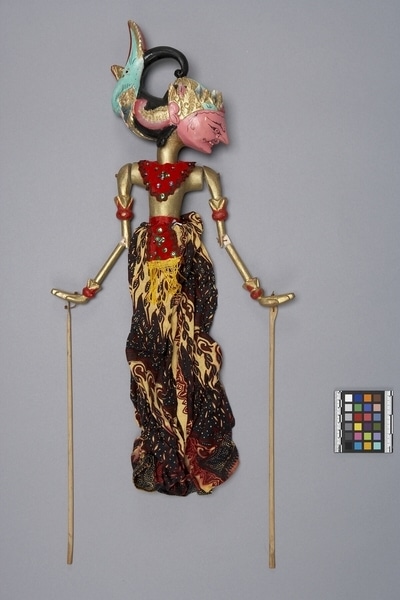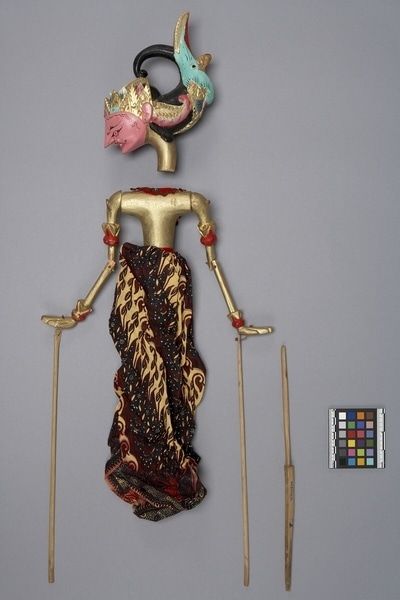Rod Puppet Item Number: Ib410 a-c from the MOA: University of British Columbia


Description
Three-dimensional male humanoid puppet: large head (part b) fits into body with skirt (part a), and a control rod (part c) with a long shaft that passes through the body and fits into the neck of the figure's head. The body has jointed arms, each with a long controlling rod attached. Pink face positioned downwards; straight pointed nose, dark pink lips and white teeth. Hair, eyebrows, moustache, facial details, and eyes outlined in black. Black upswept curl (gelung supit urang) headdress with slender green Garuda Mungkur (short tongue), with red and gold. Single siyung jawi, flower ornament in red and three grey petal surrounded by gold. Red and gold sumping. Gold, grey, green, and red two-tiered diadem with lungsen surrounding green area. Neck and torso gold; arms have red, gold ornaments at wrist and bicep. Hands held flat and bent back at wrist. Red chest covering and apron with brown trim, sequins and beads. Apron has red waistband and yellow fringe at bottom. Long batik skirt in beige with blue and purple.
History Of Use
Javanese puppetry as an art form probably developed by the 11th century. Wayang golek puppets of western Java appeared during the 16th century. Originally the plays depicted Javanese mythology, but after the Indian conquest of Java the Hindu epics, Ramayana and Mahabharata, were incorporated into the cycles, which comprise about 200 plays. A dalang (puppet master) performs the plays to celebrate important occasions, usually in three acts, with vocal and instrumental accompaniment. Typically they serve a moral and religious purpose, and more recently, one of political commentary. Many puppets, especially important ones, often have variations to denote change in state or mood. They usually have different names as well as forms.
Cultural Context
Theatrical performance.
Iconographic Meaning
Each puppet is characterized by its wanda, a Javanese word which describes the specific mixture of elements of size, form, colour, ornamentation and carving. Pink face denotes anger or aggressiveness. Fine facial features, position of face, batik, and headdress suggest virtue and high nobility. Character not identified; possibly a variation of a more standard puppet.
Item History
- Made in Java, Indonesia
- Owned by Donald Bone before January 4, 1980
- Received from Donald Bone (Seller) and Museum of Anthropology Donations Fund (Funding source) on January 4, 1980
What
- Name
- Rod Puppet
- Identification Number
- Ib410 a-c
- Type of Item
- puppet
- Material
- wood, cotton fibre, fibre and paint
- Manufacturing Technique
- carved, painted, tied, woven and sewn
- Part A
- height 57.5 cm, width 19.0 cm, depth 6.5 cm
- Part B
- height 21.7 cm, width 8.2 cm, depth 15.2 cm
- Part C
- height 34.0 cm, diameter 1.3 cm
Who
- Culture
- Sundanese
- Previous Owner
- Donald Bone
- Received from
- Donald Bone (Seller) and Museum of Anthropology Donations Fund (Funding source)
Where
- Holding Institution
- MOA: University of British Columbia
- Made in
- Java, Indonesia
When
- Ownership Date
- before January 4, 1980
- Acquisition Date
- on January 4, 1980
Other
- Condition
- fair
- Accession Number
- 0586/0030 a-c